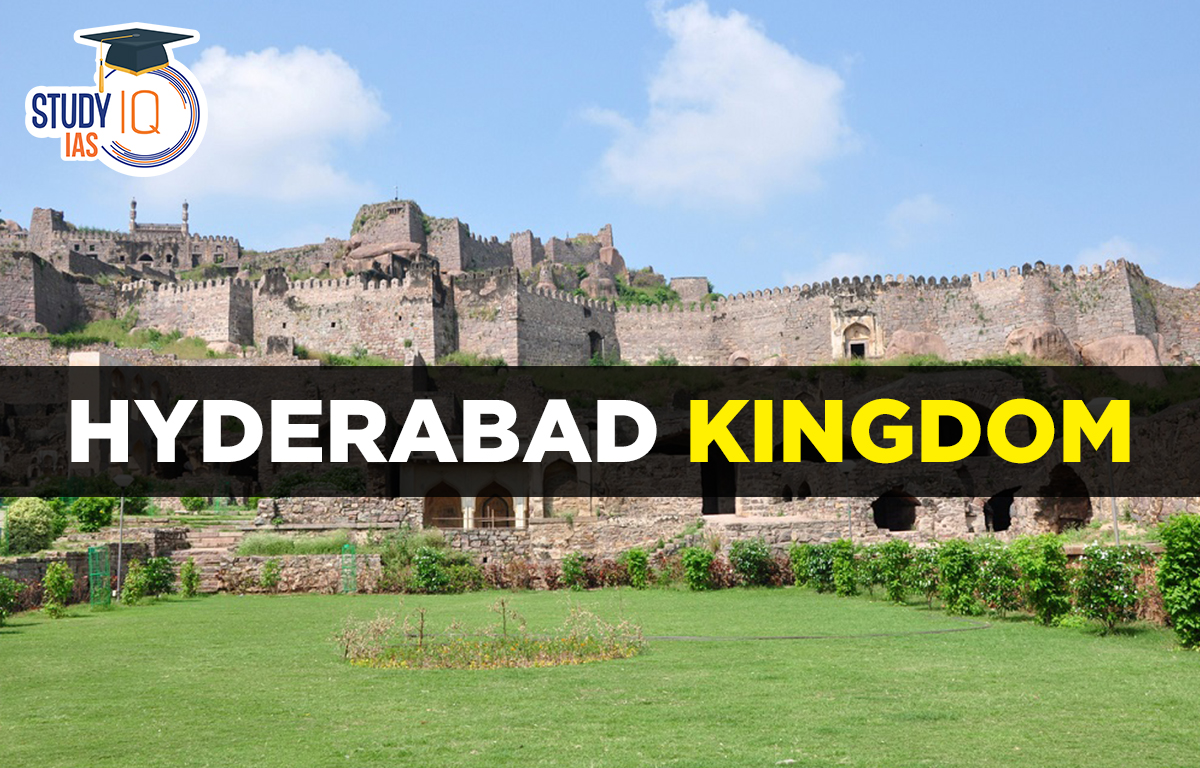Table of Contents
Hyderabad Kingdom
The Hyderabad Kingdom, commonly referred to as Hyderabad Deccan, was an independent nation in south-central India. Kilich Khan, often referred to as Nizam-ul-Mulk, was the creator of the Asaf-Jah dynasty in Hyderabad. Zulfikar Khan was the first to suggest the idea of founding a sovereign state in the Deccan. In order to prepare for the UPSC Civil Service Exam, this article will provide students with information on Hyderabad Kingdom.
Hyderabad Province History
The Nizam of Hyderabad accepted the subsidiary alliance with the British government in 1798, making Hyderabad the first Indian monarchy to do so. The Nizams, who were formerly viceroys and governors of the Mughal Empire in Delhi, were in charge of Hyderabad. When the then-Nizam Mir Qamar-ud-Din Siddiqi announced his independence and established the Asaf Jah dynasty in 1724, it became independent.
When India gained its independence in 1947, his descendants were in charge of Hyderabad state. The princely kingdoms were given the freedom to join India or Pakistan or to maintain their independence when the British opted to abandon any such contracts with them and leave India. The Nizam of Hyderabad fostered dreams of Pakistani relations or perhaps of remaining a sovereign state.
The population of his kingdom, however, was predominately Hindu, at roughly 85%. Hyderabad’s freedom was not something the newly independent India wanted since it worried it would cause the nation to become divided.
Hyderabad Kingdom Mughal conquest of Hyderabad
A further seismic shift in Deccan politics was imminent by the middle of the eighteenth century. The Mughal Emperor Aurangzeb spent the majority of his time in the Deccan, fighting the region’s Muslim and Hindu kingdoms in order to create and impose Mughal control. After Shah Jahan passed away in 1666, Aurangzeb established himself as the Emperor of Delhi and left for the south.
He fought an almost hopeless war to expand the empire past its greatest extent under Akbar for the majority of his imperial rule while fighting out of military camps in the Deccan. The opulent city of Hyderabad, which was protected by the reportedly unconquerable citadel of Golconda, was in his opinion the most precious treasure. Along with his commanders Khwaja Abid Siddiqi (Qulich Khan) and the latter’s son Ghazi-ud-Din Feroze Jung, Aurangzeb besieged Golconda in 1686.
After months of resistance, Aurangzeb was forced to flee in disgust from Golconda. When Aurangzeb came again in 1687, he besieged Fateh Maidan for nine months. In the war, Khwaja Abid Siddiqi perished and was laid to rest in Kismatpur, close to Attapur, Hyderabad. Folklore in the area claims that the fortress held out until the gates were opened at night by Abdullah Khan Pani, a saboteur who had been bought off by Aurangzeb. The independence of Hyderabad was overshadowed.
Hyderabad Kingdom Rise
The rise of the Asaf Jahi dynasty and the decline of the Mughal Kingdom are connected. Like the Mughals did with Delhi, the Asaf Jahis arrived in Hyderabad and reclaimed it as their own, not content to remain mere subedars of a larger nation. Due to a number of political developments, the Nizams came to control the Deccan. After Qalich Khan died in 1687, Aurangzeb became interested in his grandson Qamaruddin because of his extraordinary fighting skills.
When he was 19 years old, Aurangzeb gave him the title Chin Qalich Khan (Boy Swordsman). In 1713, Qamaruddin was given the greater title of Nizam-ul-Mulk Fateh Jung by Farukh Siyar, the grandson of Aurangzeb, who also appointed him as the subedar of six provinces and the faujdar of Karnataka. As an administrator, Qamaruddin has proven to be effective. The Sayyid brothers, two strong generals, however, conspired to unseat him as the Deccan’s ruler.
The Sayyids removed Qamaruddin as the Faujdar of Muradabad and banished him to Malwa during the reign of Muhammad Shah, the Mughal ruler. His success frightened the Sayyids, who demanded that he leave and move to another area. When the Sayyads were overthrown, Muhammad Shah, the new emperor, elevated him to the esteemed office of Vazir.
Later, he streamlined Deccan’s budget and administrative structure. Asaf Jah, or equal to Asaf, who served as the Grand Vizier or Prime Minister in King Solomon’s court, was given to Qamarrudin by Muhammad Shah after the latter concluded that war was pointless. The highest title a subject of the Mughal Empire could receive was Asaf Jah.
After that, Qamaruddin became an independent ruler for all intents and purposes, but he never formally renounced Delhi. As a result, Hyderabad was ruled by the Asaf Jahi dynasty till 1948.
Hyderabad Kingdom Decline
Operation Polo was the secret name given to the Hyderabad “police operation” in September 1948 by the then-independent Dominion of India against the Hyderabad State. The princely state led by Nizam was assaulted by the Indian Armed Forces during a military campaign, and it was later absorbed into the Indian Union.
The princely kingdoms of India were subject to subsidiary alliances with the British at the time of Partition in 1947, giving them control over their external relations even if they theoretically had self-government within their own borders. With the Indian Independence Act of 1947, the British ended all such alliances, giving the states the option of full independence.
Hyderabad and the Dominion of India agreed to a standstill agreement in November 1947, which maintained all existing arrangements with the exception of the stationing of Indian forces in the state.
Hyderabad Kingdom UPSC
From 1724 to 1948, Hyderabad had enormous cultural and economic growth. The Nizams, who were among the richest individuals in the world, were well-known patrons of literature, art, architecture, and gastronomy. Asaf Jah VII was really listed as the fifth-richest person in history. The Nizam made the decision not to join the Indian Union following India’s independence in August 1947. For the UPSC Exam, this article provides comprehensive information on Hyderabad Kingdom.


 Indus River System, Tributaries, and Sin...
Indus River System, Tributaries, and Sin...
 Jallianwala Bagh Massacre, Date, History...
Jallianwala Bagh Massacre, Date, History...
 Important Lakes of India, State wise and...
Important Lakes of India, State wise and...





















